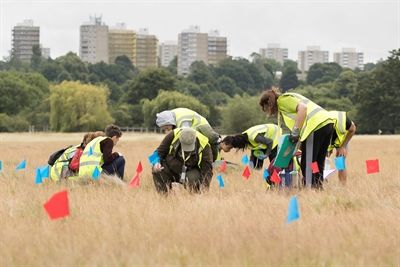On Saturday 15 September at 10.15 in Pembroke Lodge, Dr Tim King of Oxford University will talk on the ant hills of Richmond Park.
His similar talk last year was a fascinating insight into a whole world about which most of us knew very little. After the talk he'll be leading a walk (or is it an expedition?) to examine the ant hills and yellow meadow ants at close quarters.
Coffee & tea are available before the talk.
The following is an article that appeared in the Friends' summer newsletter.
Ant Hills and Citizen Science
Richmond Park has 400,000 ant-hills containing over 1 billion yellow meadow ants (2,500 per anthill). That’s the estimate of the ‘Citizen Science’ work done last July by over 100 volunteers as part of The Royal Parks’ Mission Invertebrate project, led by Dr. Tim King of Oxford University.
The ants live on aphids they ‘farm’ in the areas between the mounds. The ants in turn are the main source of food for the green woodpecker, the Park’s iconic bird. The anthills provide dunging sites for rabbits, nesting, egg-laying and basking sites for many insects and a home for invertebrates that are only found living with the ants.
Previous research has shown that the richness of plant and animal species in and around the anthills increases with anthill and grassland age, so the older anthills should be the highest priority for conservation. Fortunately, Dr. King found that “Richmond Park is probably the best documented 1,000 hectares in Britain over the last 380 years”. He was therefore able to choose eight anthill areas that have a range of ages – defined as the time that the grassland has been undisturbed – from the oldest near Pen Ponds (last disturbed in 1637) to the youngest near Sheen and Roehampton Gates which was last disturbed in the 1980/90s through slurry spreading, mowing and use as playing fields.
Dr. King and the volunteers sampled 850 anthills in these eight areas. Their results show that the average size of anthills at the oldest site is 50 cubic litres which is around twice the size at the youngest site. Dr King has found that the size of the largest 5% of anthills in an area is a good indication of its age, meaning that future researchers need only sample a few anthills to know how old the anthills are.
Currently, Dr King is testing whether old anthills can be successfully moved to a new location when an area is being redeveloped. This spring some anthills were moved to make way for a backwater being created on Beverley Brook. So far the move has been successful in that the anthills didn’t break up and the ants seem to have taken to their new location. But with 100-year old anthills it will take a few years to know for sure.


